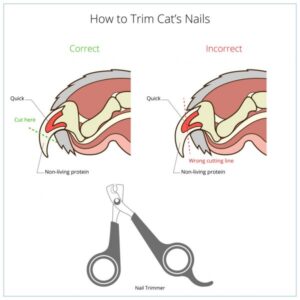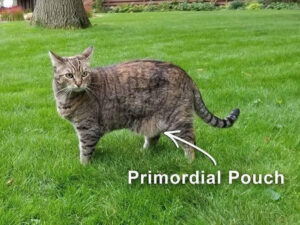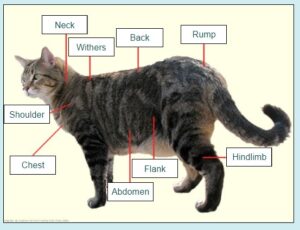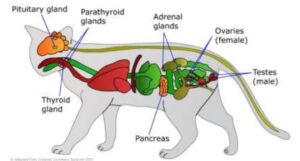Your cat’s whiskers are truly multifunctional, but their most important purpose is as a sensory tool. The official title for them is vibrissae, which comes from Latin ‘vibrio’ and means ‘to vibrate’. The hair follicle of your cat’s whiskers is loaded with nerves, and the whisker tip features a sensory organ known as a proprioceptor. Together, this makes them incredibly sensitive to vibrations and changes in their environment, so cats use them like an additional sense to understand the world. Additionally, whiskers are also much more deeply embedded in their body than normal fur hair, as they’re connected to the muscular and nervous system. This enables whiskers to send sensory messages to the brain about your cat’s surroundings, which is what makes them such savvy explorers!

Where you may think that your cat’s whiskers are limited to just around their nose, they’re also above their eyes, ears, jaw and forelegs!
The whiskers on their forelegs (carpal whiskers) are one of the reasons they’re such successful hunters as they help to determine movement of prey.
Cats have an even number of whiskers on their muzzle with 24 in total. Each side has 12 whiskers in a completely symmetrical distribution, so they can accurately measure the environment.
You may have seen your cat put their head into an opening before the rest of their body. This is because their whiskers work as a built-in ruler! Because whiskers are placed around the width of your cat’s body, it means they are excellent at helping your cat gauge how tight a space is.
Your cat’s whiskers can sense vibrations in the air, making them incredibly useful when measuring distances or chasing prey. Additionally, they can also detect changes in air currents, enabling them to sense approaching dangers – making them sort of like their very own radar.
It may surprise you to learn that your cat’s close up vision isn’t very good and they can’t easily see anything closer than 30cm in front of them. They use their whiskers to navigate the world straight ahead, as by touching them against an object they can tell where it is, its size and even the texture.
If you’ve ever wondered how your cat seamlessly moves around during the night without bumping into anything, it is in part because of their whiskers! The air currents in a room are different depending on where furniture is placed and their intelligent whiskers pick up on this and tells their brain where things are. Pretty cool, right? This, combined with cat’s having much better night vision than humans, means they are much more able to navigate their way around in the dark than their owner would be able to!
Whiskers can also give you an insight into a cat’s behaviour or emotions. If their whiskers are rigid and pulled around their face it means they may feel threatened, whereas, if their whiskers are relaxed, it indicates that your cat may be feeling happy and content. Additionally, if you notice that your cat’s whiskers are pushed forward it may mean that they’re interested or curious.
Your cat’s whiskers also serve to protect your cat’s sensitive spots from possible danger or injury. The whiskers around their eyes respond to the tiniest touch (even a small speck of dust), allowing your kitty to shake or blink to remove it. Also, when your cat is outside exploring the world, their whiskers will detect sharp things first, offering essential protection to their eyes and face. You should never, ever, cut your cat’s whiskers. They are vital for so many things that if you snip them off, your cat can get very disorientated and scared as they’ll be unable to gauge or sense their environment. Don’t worry if you find one or two that have fallen out though, they do grow back!

Cats use their claws for all sorts of things – jumping, climbing and hunting – but while we’re spending more time with our feline friends you might be noticing just how long they are!
Cats having claws is perfectly natural – in fact they’re so important to cats that ‘de-clawing’ is illegal in the UK. But sometimes, they can get a little too long if your cat isn’t able to wear them down properly.
It’s always best to give your cat ways to wear their claws down naturally rather than clipping them. If they’re given lots of opportunity to scratch and condition their claws, they’re more likely to stay a good length so you won’t need to trim them.
If you’ve ever been playing with your cat and gotten a little too close, you might have felt just how sharp their claws are! While playing, it’s natural to be able to see your cat’s claws. Cats’ front claws are retractable, meaning that when they’re resting, you’re unlikely to be able to see them at all. This also means that when they walk, they can do so quietly and without getting stuck on anything.
If your cat’s claws are too long, you might notice they’re starting to catch on the carpet or tap against hard floors. You may be able to clearly see their claws, even when they’re resting. As our cats get older it’s definitely worth keeping an eye on their claws. If they develop arthritis, can’t retract their claws, or find it painful to claw things to keep their claws sharp and short they may need a bit of extra help. Long-haired cats in particular need regular checking as it can be hard to see if their claws are too long because of all the excess fur!
If your cat’s claws get too long, they can start to curve and grow into their paw pads causing a lot of pain and problems for your kitty. It’s best to keep an eye on your cat’s claws so you know if they’re starting to get too long and if you suspect they’ve grown into the pad, it’s best to call your vet for their help.
I would always recommend a chat with your vet first if you think there is something wrong with your cat’s claws (for example, if they have grown into the pad or you can see blood or swelling in their toes).
You should only trim your cat’s nails if they are too long, not because they are sharp. It’s best to speak to your vet if you’re unsure. If your vet has advised you to cut your cat’s claws, you need to do so slowly and carefully. You’ll need some cat nail clippers or cat nail scissors, and your cat’s favourite treats. We wouldn’t recommend using human nail clippers, as these can cause your cat’s claws to split.
It’s also important to remember that once you’ve trimmed your cats nails they will want to sharpen them again so be prepared for them to scratch more (and sometimes in new places!) to get their nails back to their normal pointed shape.
For a good few days before, you’ll want to get your cat used to having their paws touched. Start to build them up by gently touching their paws and giving them a treat if they stay calm, but stop if they start to look uncomfortable or stressed.
When they’re happy to have their paws touched, you can start clipping:
- Settle your cat in a quiet room, ideally somewhere you can easily get to their paws (so try to avoid getting them settled on top of a wardrobe). On your lap is ideal. You want them to be nice and relaxed before starting. Make sure you have a soft surface for them to land on if they decide to jump down for example putting down some cushions next to the chair.
- Make sure your cat is happy with the clippers. Let them sniff them and investigate if they’re interested and give them a tasty reward.
- Apply gentle pressure to the top and bottom of your cat’s paw to extend their claws. You may have to push a little but this should only be very gentle.
- Avoid the quick at the base of the claw nearest the toe – this is the pink bit of your cat’s claw and contains a small blood vessel. You should never cut this bit as it will bleed and be painful to your kitty. Just stick to the white safe area at the tip and if you can see the quick it’s best to clip about 3-4mm below this.
- It’s very rare to make a claw bleed as the quick is usually obvious but if you do notice any blood, stop and call your vet for advice.
- Take your time and don’t try to cut all your cat’s claws in one sitting. Try trimming one first, then reward your cat. If that didn’t send them running, trim another then reward them again. Stop straight away if your cat is unhappy or trying to run away.
- Never shout at your cat or hold them too tightly. You want claw clipping to be a good experience for them so they won’t mind it so much in future. Shouting or holding them tightly will only make them hate it even more and send them packing as soon as they see you with the clippers!

The primordial pouch is a loose flap of skin that runs along the length of the cat’s belly but is most pronounced towards the rear. It can often be seen swaying from side to side when the cat walks or trots. Pet owners often attribute the primordial pouch to weight gain, but it is common on cats of all shapes and sizes, even slim ones.
We don’t know for sure, but the most obvious theories are that it serves four purposes.
Firstly, the primordial pouch acts as a protection to the internal organs during a fight or attack. If you have ever seen cats in a fight, you may have noticed that they often kick each other with their hind legs and their sharp claws which could potentially damage these vital organs. Secondly, allows cats to stretch out when running at high speed or jumping. Thirdly, for greater stomach expansion if a cat gorges on a large meal and lastly to provide a fat reserve in the event of leaner times. However, I’m not convinced about this because the primordial pouch is mostly loose skin and fur.

Above is a labelled diagram of the anatomical parts (landmarks) of a cat.

Above are some of the Internal Anatomical landmarks and organs of the body. The body is divided into Major and Minor cavities.

Above is the endocrine system which consists of ductless glands known as endocrine glands. The endocrine glands are distributed throughout the body. They produce hormones that can influence the animal’s behaviour and mood.
If you would like to read more information on how to look after your cat, try this blog https://alicatpurrfections.co.uk/alicat/would-you-know-what-to-do-in-an-emergency/
If you would like to book Alicat Purrfections to take care of your cats any time you can not be there, check out these reviews to give you peace of mind you have made the right choice https://alicatpurrfections.co.uk/alicat/reviews/

